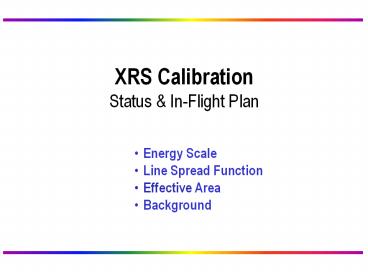XRS Calibration - PowerPoint PPT Presentation
Title: XRS Calibration
1
XRS Calibration Status In-Flight Plan
- Energy Scale
- Line Spread Function
- Effective Area
- Background
2
Energy Scale
- The energy scale is a complicated, non-analytic
function. Using a physical model for the
pulses, we find that E(V) can be well
characterized by a 4th order polynomial. For
ground calibration data this gives an energy
scale that is accurate to DE 0.5 eV
3
Energy Scale In-Flight
The energy scale must be re-established
in-flight. We will use offset pointings of
Capella and GX301-2 to illuminate all pixels.
Line Energy (keV) Inner Pixel Outer Pixel
N VII Lya 0.500 105 58
O VIII Lya 0.654 1045 404
Ne X Lya 1.022 1051 407
Mg XII Lya 1.473 279 108
Si XIV Lya 2.006 70 27
K Ka 3.314 186 186
Mn Ka 5.894 6200 6200
Fe Ka 6.400 3320 1262
Ni Ka 7.461 105 40
4
Energy Scale Drift Correction
17K IF 14.875 K ADR CP 1.254 K
Changes in the energy scale will be tracked using
an offset pixel. During ground
calibration we discovered that the calibration
pixel and the array pixels respond differently to
changes in the thermal environment. This
is very difficult to characterize. For small
changes in temperature, the drift is linear. Cal
Pixel DTNe 40 eV/K DTHe 130 eV/K
17K IF 15.050 K ADR CP 1.230 K
17K IF 15.480 K ADR CP1.226 K
5
Line Spread Function
The line spread function is well characterized by
a Gaussian function. This resolution
kernel is measured using a 55Fe source. For the
most flight-like conditions we find Composite D
EFWHM 5.6 eV Pix mean DEFWHM 5.3 eV Std
dev s 0.2 eV The energy dependence
appears to follow the predictions of the pulse
model.
6
Line Spread Function Low Energy Shoulder
- There is a low energy shoulder due to photo- and
electron-escape events. A monte-carlo is being
developed. It depends on both the photoelectric
absorption cross-sections and the electron
interaction with the solid state HgTe absorber.
7
Effective Area
- Aeff Atel htel Phfilters hintercept hQE
helectonics
Telescope Described by Kai-Wing Chan Blocking
Filters Aluminum and oxides in the filters
produce absorption structure at low energies.
This is measured on the ground. Pixel Intercept
This will depend on the boresight, the telescope
PSF and the alignment of the pixels. Absorber
Quantum Efficiency This depends on the column
density of the HgTe absorbers. The absorbers
have been measured and weighed, and the Hg L
absorption edges have been measured. Electronics
At high count rates some events will not be
identified by the pulse detection algorithms.
This pile up will decrease the effective area
by a few percent.
8
Effective Area Components
Filter Transmission
Quantum Efficiency
9
Effective Area In-Flight
The goal of the in-flight calibration is to
verify the discrete structure and characterize
the global effective area. We will use the
bright, featureless BL Lac 3C273 as a backlight.
Simultaneous observations and cross-calibration
with XMM-Newton/Chandra are required.
Al K Edge
10
Effective Area In-Flight
To monitor the presence of ice contamination on
the blocking filters we will observe line-rich
SNRs N132D and 1E0102-72 repeatedly during the
early phases of the mission.
N132D Line E (keV) Cts
N VII Lya 0.500 65 O VIII Lya 0.654 1900 O VIII
Lyb 0.775 850 Ne Lya 1.022 2500 Mg Lya 1.472 500
11
Background
Primary cosmic ray protons The anticoincidence
detector identifies all but 0.1 of events due
to primary protons. Protons that hit the frame
cause simultaneous pulses on multiple pixels that
can be rejected by the processing software.
Secondary electrons and photons To estimate
the unrejected background due to secondary
events, we scale the ASCA rate ? 7 x 10-4
events/s.































